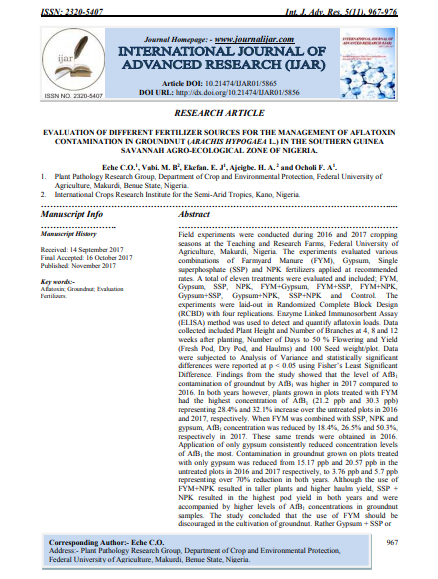Evaluation of Different Fertilizer Sources for the Management of Aflatoxin Contamination in Groundnut (Arachis hypogaea L.) in the Southern Guinea savannah Agro-Ecological Zone of Nigeria
Summary
Field experiments were conducted during the 2016 and 2017 cropping seasons at the Teaching and Research Farms, Federal University of Agriculture, Makurdi, Nigeria. The experiments evaluated various combinations of Farmyard Manure (FYM), Gypsum, Single superphosphate (SSP) and NPK fertilizers applied at recommended rates. A total of 11 treatments were evaluated and included: FYM, Gypsum, SSP, NPK, FYM+Gypsum, FYM+SSP, FYM+NPK, Gypsum+SSP, Gypsum+NPK, SSP+NPK, and Control. The experiments were laid out in Randomized Complete Block Design (RCBD) with four replications. The Enzyme Linked Immunosorbent Assay (ELISA) method was used to detect and quantify aflatoxin loads. Data collected included Plant Height and Number of Branches at 4, 8, and 12 weeks after planting, Number of Days to 50% Flowering and Yield (Fresh Pod, Dry Pod, and Haulms) and 100 Seed weight/plot. Data were subjected to Analysis of Variance and statistically significant differences were reported at p < 0.05 using Fisher’s Least Significant Difference. Findings from the study showed that the level of AfB1 contamination of groundnut by AfB1 was higher in 2017 compared to 2016. In both years, however, plants grown in plots treated with FYM had the highest concentration of AfB1 (21.2 ppb and 30.3 ppb), representing a 28.4% and 32.1% increase over the untreated plots in 2016 and 2017, respectively. When FYM was combined with SSP, NPK, and gypsum, AfB1 concentration was reduced by 18.4%, 26.5%, and 50.3%, respectively in 2017. The same trends were obtained in 2016. Application of only gypsum consistently reduced concentration levels of AfB1 the most. Contamination in groundnut grown on plots treated with only gypsum was reduced from 15.17 ppb and 20.57 ppb in the untreated plots in 2016 and 2017 respectively, to 3.76 ppb and 5.7 ppb, representing over 70% reduction in both years. Although the use of FYM+NPK resulted in taller plants and higher haulm yield, SSP + NPK resulted in the highest pod yield in both years and were accompanied by higher levels of AfB1 concentrations in groundnut samples. The study concluded that the use of FYM should be discouraged in the cultivation of groundnut. Rather, Gypsum + SSP or Gypsum + NPK should be promoted since their use was associated with reduced levels of aflatoxin contamination and better pod and haulm yields.
Open resource Download resource Access resource on external site

